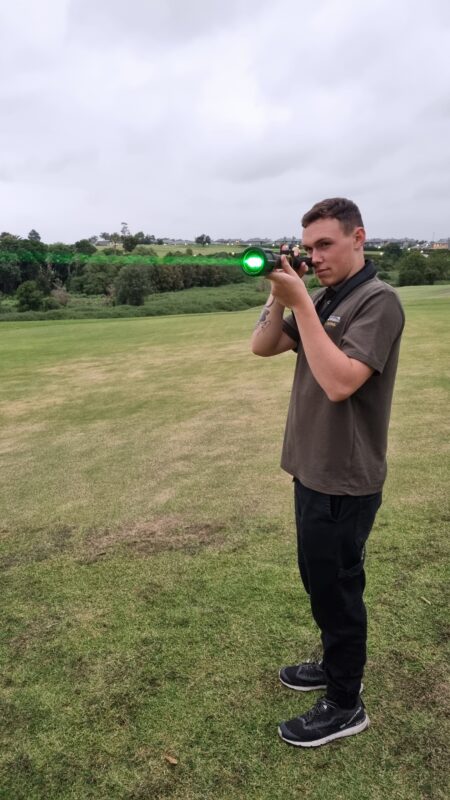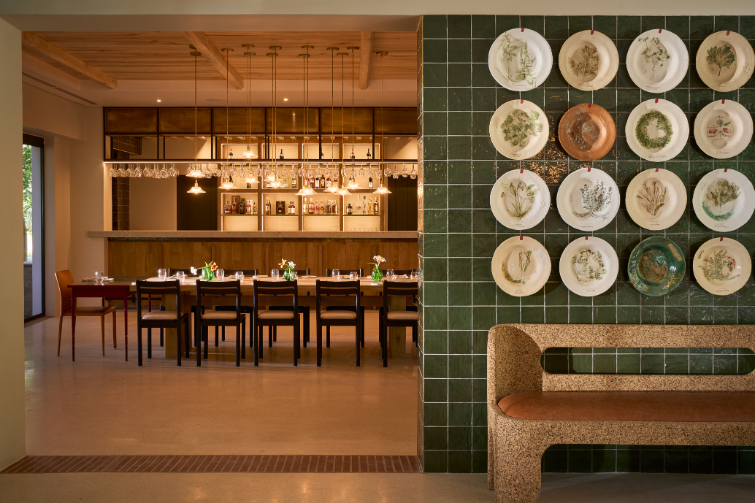Crop damage from birds remains a significant problem for many vineyards, but most solutions have been expensive and unsatisfactory. Lasers have been a deterrent for many years, and the technology can be a powerful ally in the right hands.

The hand-held bird laser in action at a gholf course.
Bird Control Group, the international company that manufactures these bird-busting lasers, was established in Delft, the Netherlands, in 2012. Since then, the technology has been deployed successfully in various environments where birds are a problem, including vineyards.
The company manufactures hand-held lasers, which can be carried around to deter birds’ nesting and feeding habits. The lasers don’t have to be aimed directly at individual birds since the beam’s mere presence in the vicinity appears as a threat. “Laser bird control technology mimics natural instincts,” explains Ani Manukyan, Global Marketing Lead for Bird Control Group. “Birds, which rely heavily on vision, perceive the green spectrum of laser lights as tangible threats. The movement of the laser activates their instinct to escape danger.”
Bird Control Group also manufactures an autonomous laser that can be mounted in problem areas. Stellenbosch University successfully trialled the system for its Plant Breeding Laboratory (PBL) at the Welgevallen Experimental Farm in 2017.
Installation and use
The AVIX Autonomic system is versatile and can operate on grid and solar power. “Coverage varies based on factors such as terrain, bird species, population density, and crop types,” Ani says. “Generally, each laser can protect an area of about 5 to 7 hectares.”
To be effective, the bird laser has to be elevated 1 meter for every 100 meters of depth over the crops, with a minimum recommended height of 4 to 5 meters. Ani says that properly mapping danger zones and considering safety margins are also crucial.
The autonomous system also integrates with a mobile app, allowing configuration and monitoring via Bluetooth. “This includes setting new waypoints, updating the system, and checking its status,” Ani says. The app is available for Android and iOS platforms.
Bird Control Group’s range of laser-based solutions is designed with sustainability in mind. It aims to strike a balance between commercial interests and the welfare of birds. One of its products has even been recognised by the World Wildlife Fund.
Local partners
Earlier this year, Bird Control Group partnered with local provider Falcon Crest Group (FCG) to provide installation, calibration, and maintenance of the lasers in south Africa. The company follows a multi-pronged approach to bird control, and the lasers complements other services, which include falconry, dogs, gels, drones, traps, and (as a last resort) culling.
“We’re always looking for innovative products entering the market,” says Francois Breedt, FCG head of business development. “There’s no silver bullet; effective bird control requires an understanding of their behaviour and addressing the problem holistically.”
The idea is to create a stressful environment for the birds, discouraging nesting or foraging in the area. “My suspicion is that the birds recognise the laser as a flame, or fire; they’re petrified of it. It works especially well for smaller birds like starlings and mousebirds.”
Tailor-made success
The lasers are powerful enough to cause permanent damage if used improperly. Like most companies in the pest control industry, FCG has opted to provide their solution on a rental basis with an insurance policy in place. This helps protect the quality and integrity of their business. “This isn’t something you just sell to someone, and their problems are solved,” Francois explains. “We must train people to use the laser safely and effectively.”
As with the drone industry, serious abuses might prompt authorities to introduce more regulation and red tape, which would remove one of the technology’s chief advantages: it requires no special license to operate. Due diligence and responsible usage is part of the business model.
The rental model makes the platform affordable and gives clients the flexibility to use it when needed, rather than incurring significant expenses for a system that might only be used for a few weeks each season. “The automated system is prohibitively expensive, while the hand-held laser can be operated by anyone on the farm with the training we provide.”
Francois suggests getting in touch for a demonstration. The team can assess the need and suggest a suitable strategy based on the size of the area, bird species, and time of day to ensure the birds stay away. “Birds are a complex problem – each situation is unique and every region has different birds. You need a flexible solution. But this system works.”
And don’t underestimate the novelty value of such a high-tech solution. Recently, a video by Evan Bellingar, the owner of Bellingar Estates in Oregon, raked up thousands of views when he shared his experience with the laser on Instagram, which reached over 10 million people. “It took me two posts to get from 1 500 to 13 000 followers,” he said. “It was really fun to share agricultural education and dispel misinformation about the laser, as some assumed it harmed the birds when, in fact, it doesn’t.”
WATCH – The automated bird laser in action













